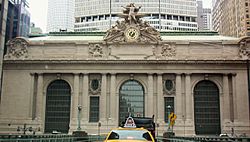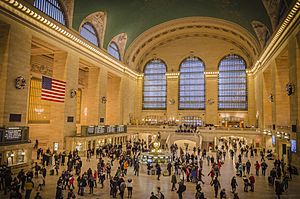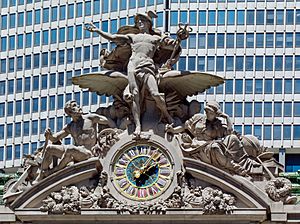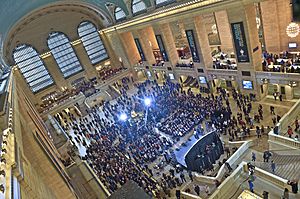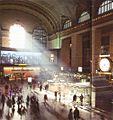Grand Central Terminal facts for kids
Grand Central Terminal (GCT) — often called Grand Central Station or simply Grand Central — is a train station in New York City. Located at 42nd Street and Park Avenue in Midtown Manhattan, it is the largest train station in the world by number of platforms.
Contents
Name
Grand Central Terminal was named by and for the New York Central Railroad, which built the station and its two predecessors on the site. It has "always been more colloquially and affectionately known as Grand Central Station", the name of its immediate predecessor that operated from 1900 to 1910. The name "Grand Central Station" is also shared with the nearby U.S. Post Office station at 450 Lexington Avenue and, colloquially, with the Grand Central–42nd Street subway station next to the terminal.
History
The first station at this site was built in 1871 by the New York Central Railroad at a time when there were many long-distance passenger trains in the United States which most people took to move across the country. Back then it was called "Grand Central Depot". In 1913 the station was rebuilt and given its current name, "Grand Central Terminal", but today many people call it "Grand Central Station".
Architecture
Grand Central Terminal was designed in the Beaux-Arts style by Reed and Stem, which handled the overall design of the terminal, and Warren and Wetmore, which mainly made cosmetic alterations to the exterior and interior. Various elements inside the terminal were designed by French architects and artists Jules-Félix Coutan, Sylvain Salières, and Paul César Helleu. Grand Central has monumental spaces as well as meticulously crafted detail, especially on its facade, which is based on an overall exterior design by Whitney Warren.
The terminal is widely recognized and favorably viewed by the American public. In America's Favorite Architecture, a 2006-07 public survey by the American Institute of Architects, respondents ranked it their 13th-favorite work of architecture in the country, and their fourth-favorite in the city and state after the Empire State Building, Chrysler Building, and St. Patrick's Cathedral. In 2013, historian David Cannadine described it as one of the most majestic buildings of the twentieth century and the American Society of Civil Engineers designated it a Historic Civil Engineering Landmark.
As proposed in 1904, Grand Central Terminal was bounded by Vanderbilt Avenue to the west, Lexington Avenue to the east, 42nd Street to the south, and 45th Street to the north. It included a post office on its east side. The east side of the station house proper is an alley called Depew Place, which was built along with the Grand Central Depot annex in the 1880s and mostly decommissioned in the 1900s when the new terminal was built.
As first built, the station house measured about 722 feet (220 m) along Vanderbilt Avenue (120 feet longer than originally planned) and 300 feet (91 m) on 42nd Street. Floors above the first story are set back about 50 feet, making the rest of the station house originally measure 290 by 670 feet. The station is about 125 feet (38 m) tall.
Layout
Grand Central Station covers an area of 48 acres and has 44 platforms on two levels, with 67 tracks along them. There are 41 tracks on the upper level and 26 tracks on the lower level. All of them are built underground at the end of a long tunnel under Park Avenue, where trains have to change from diesel to electric power using a third rail to avoid problems with exhaust. These platforms serve commuters traveling on the Metro-North Railroad to Westchester County, New York, Putnam County, New York, and Dutchess County, New York in New York State, and Fairfield County, Connecticut and New Haven County, Connecticut in the state of Connecticut.
Renovation and subsequent expansions
In 1988, the MTA commissioned a study of Grand Central Terminal, which concluded that parts of the terminal could be turned into a retail area.
In 1995, the agency began a $113.8 million renovation of the terminal's interior. All advertisements were removed and the station was restored; for example, the Main Concourse ceiling was cleaned to reveal the painted skyscape and constellations. The East Stairs, a curved monumental staircase on the east side of the Main Concourse, was added to match the West Stairs. The project's completion was marked with a re-dedication ceremony on October 1, 1998.
In December 2006, American Financial sold Grand Central Terminal to Midtown TDR Ventures, LLC, an investment group controlled by Argent Ventures, which renegotiated the lease with the MTA to last until 2274. In 2018, the MTA exercised its option to purchase the terminal, along with the Hudson and Harlem Lines. The agency took ownership of the terminal and rail lines in February 2020.

On February 1, 2013, numerous displays, performances, and events were held to celebrate the terminal's centennial. The MTA awarded contracts to replace the display boards and public announcement systems and add security cameras at Grand Central Terminal in December 2017. The MTA also proposed to repair the Grand Central Terminal train shed's concrete and steel as part of the 2020–2024 MTA Capital Program. In February 2019, it was announced that the Grand Hyatt New York hotel that abuts Grand Central Terminal to the east would be torn down and replaced with a larger mixed-use structure over the next several years. In September 2020, the skyscraper One Vanderbilt opened, along with a train hall at its base, a pedestrian plaza connecting it to the terminal, and an underground passage to the complex's subway station. The plaza was built on a section of Vanderbilt Avenue, permanently closing the section to automobile traffic for the first time.
In January 2023, the MTA's new Grand Central Madison station opened beneath Grand Central Terminal. The new station, serving the Long Island Rail Road, was under development since 2007. The project, officially titled East Side Access, cost $11.1 billion. LIRR trains arrive and depart from a bi-level, eight-track tunnel with four platforms more than 90 feet (27 m) below the Metro-North tracks. The station includes a new 350,000-square-foot retail and dining concourse and new entrances at 45th, 46th, and 48th streets.
Images for kids
-
Baggage car mistakenly identified as Franklin D. Roosevelt's personal car, on display at the Danbury Railway Museum
-
The MetLife Building was completed in 1963 above part of Grand Central Terminal.
-
The Main Concourse in 1986, featuring the Kodak Colorama, the illuminated clock, and two banks
-
The Helmsley Building, in front of the MetLife Building, was built as part of Terminal City, a commercial and office district created above the tracks
-
Saturday Night Live stage replica at a Museum of Broadcast Communications exhibition, 2018
See also
 In Spanish: Grand Central Terminal para niños
In Spanish: Grand Central Terminal para niños


